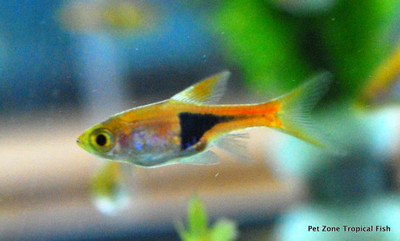Harlequin Rasbora
Posted by Max Gandara on on 9th Jul 2025
Harlequin Rasbora: The Jewel of Community Tanks
(Trigonostigma heteromorpha)
Elegant, peaceful, and effortlessly beautiful—the Harlequin Rasbora is a staple of the freshwater aquarium hobby. With its vibrant orange body and striking black “harlequin” patch, this Southeast Asian native brings both color and harmony to any community or planted aquarium.
Whether you're a beginner or an aquascaping pro, this small schooling fish offers the perfect mix of low maintenance and high visual appeal.
Quick Facts
-
Common Name: Harlequin Rasbora
-
Scientific Name: Trigonostigma heteromorpha
-
Origin: Malaysia, Thailand, Sumatra, Singapore
-
Adult Size: 1.5–2 inches
-
Temperament: Peaceful, schooling
-
Lifespan: 5–8 years
Striking Appearance
The Harlequin Rasbora’s classic look features a shimmering copper-to-rose-gold body, accented by a dramatic black triangular patch that starts near the dorsal fin and ends at the base of the tail. The contrast gives the fish its “harlequin” name and makes it stand out beautifully—especially when kept in a group.
Behavior & Schooling
These fish are natural schoolers and do best in groups of six or more. In larger numbers, their movement becomes more cohesive and visually striking, especially in a planted tank. They are peaceful and non-aggressive, making them ideal tankmates for many other community species.
Ideal Tank Setup
? Tank Size:
Minimum of 10 gallons for a small group, but 20+ gallons is ideal for a larger, more active school.
? Aquascaping Tips:
-
Use dark substrate to enhance their coloration
-
Include live plants, driftwood, and gentle flow
-
Provide open swimming areas in the middle of the tank
? Water Parameters:
-
Temperature: 72–80°F
-
pH: 6.0–7.5
-
Hardness: 2–10 dGH
-
Soft, slightly acidic water mimics their natural habitat best
Feeding
Harlequin Rasboras are micro-predators in the wild and adapt well to a wide range of foods in captivity:
-
High-quality flakes or micro-pellets
-
Frozen or live foods like daphnia, brine shrimp, or bloodworms
-
Occasional veggie-based foods to round out their diet
Feed once or twice daily in small amounts they can consume within a few minutes.
Tankmates
Thanks to their gentle nature, Harlequin Rasboras pair well with:
-
Neon Tetras, Ember Tetras, and other small schooling fish
-
Corydoras Catfish
-
Dwarf Gouramis
-
Otocinclus and other peaceful algae eaters
-
Shrimp (in larger setups)
Avoid housing them with aggressive or fin-nipping species.
Breeding Notes
Breeding is possible in a dedicated tank with soft, slightly acidic water and fine-leaved plants or spawning mops. Males are slimmer and more brightly colored, while females are slightly rounder. They are egg scatterers and do not guard their eggs—so remove adults after spawning.
Final Thoughts
The Harlequin Rasbora is a timeless favorite for a reason. With its vibrant colors, peaceful temperament, and cohesive schooling behavior, it adds movement and charm to any tank. Easy to care for yet endlessly elegant, it’s a perfect species for beginners and experts alike.
Looking to bring life and harmony to your aquarium? A group of Harlequin Rasboras might just be the perfect fit.

